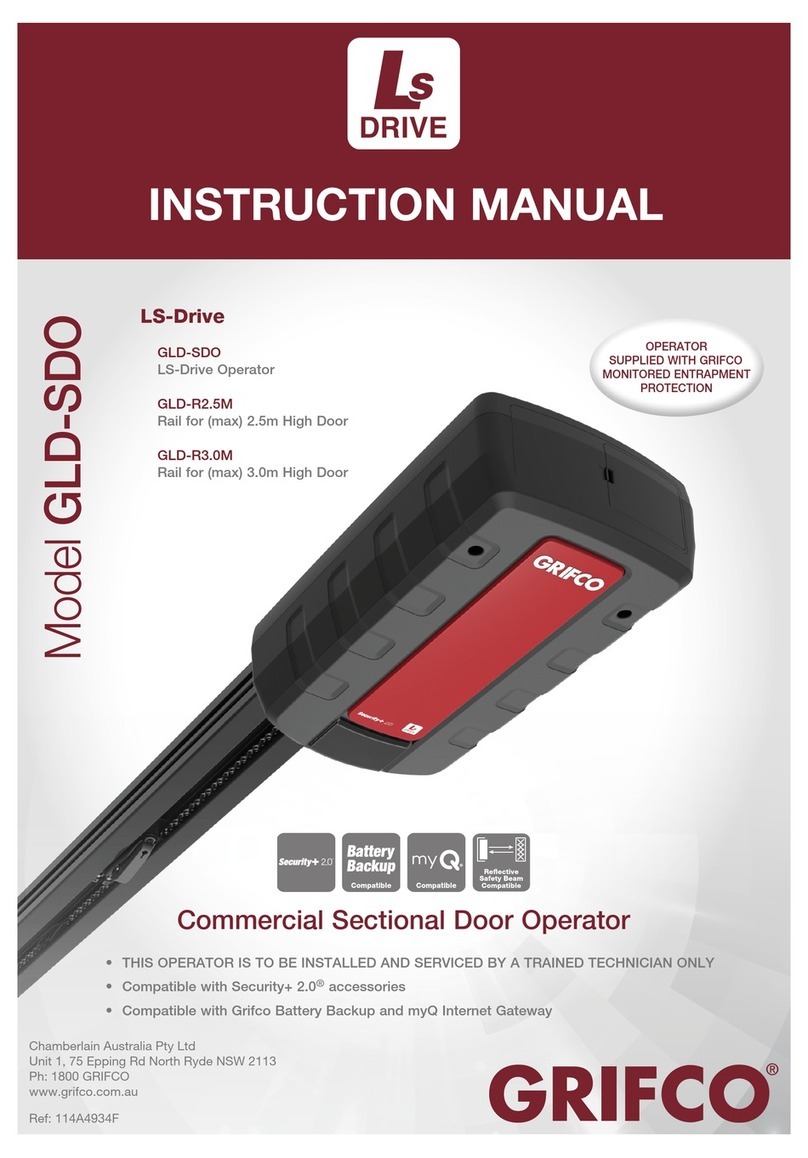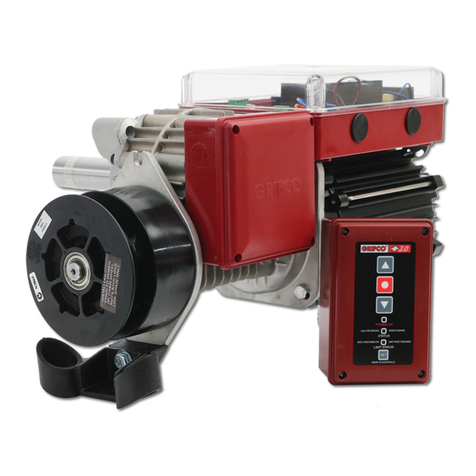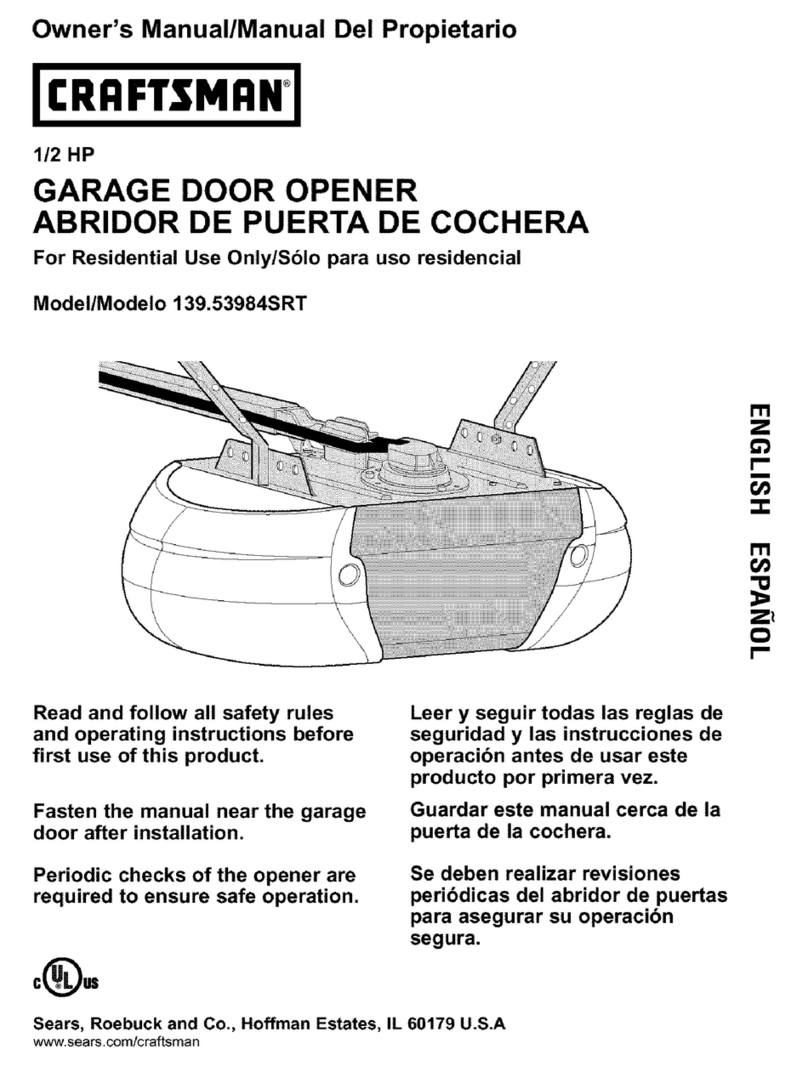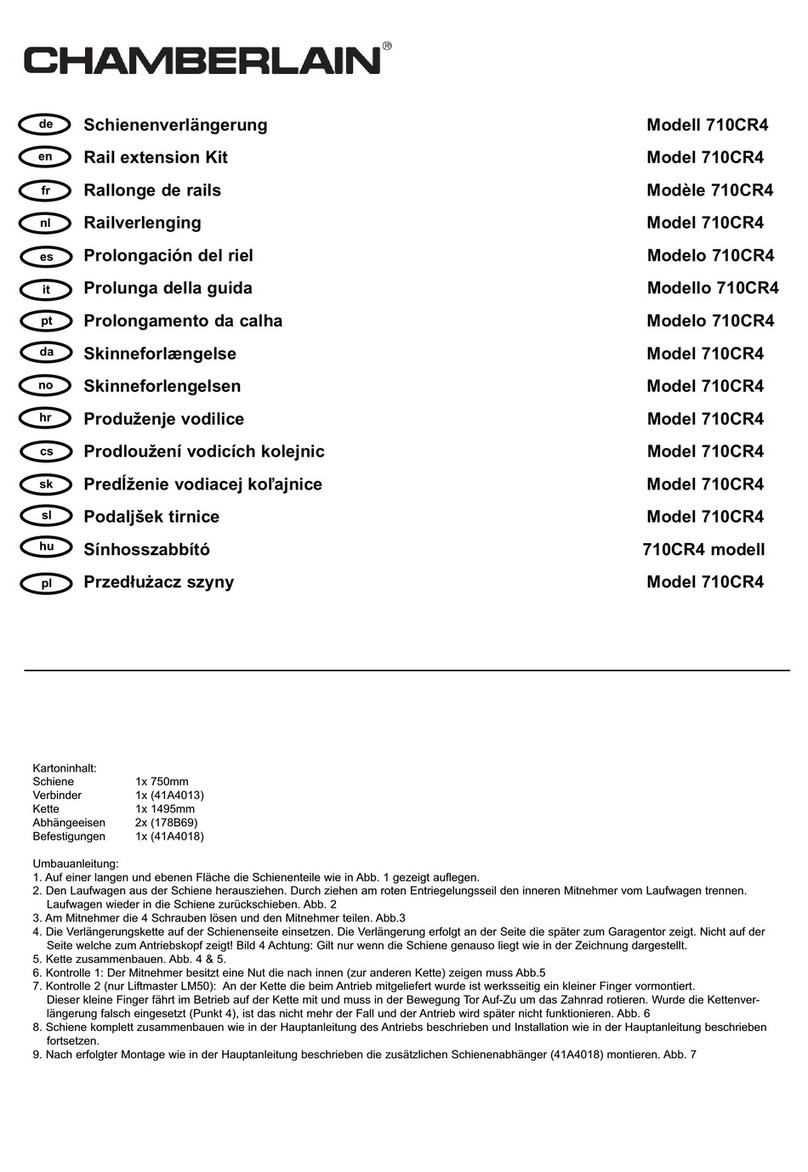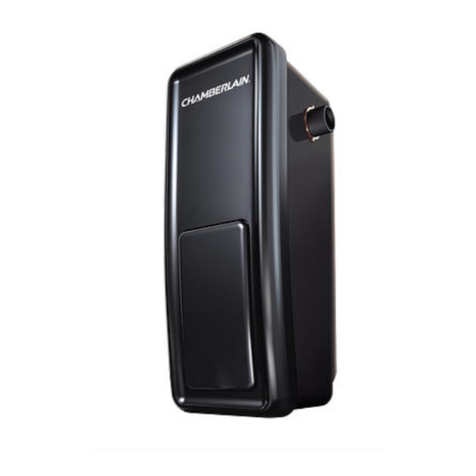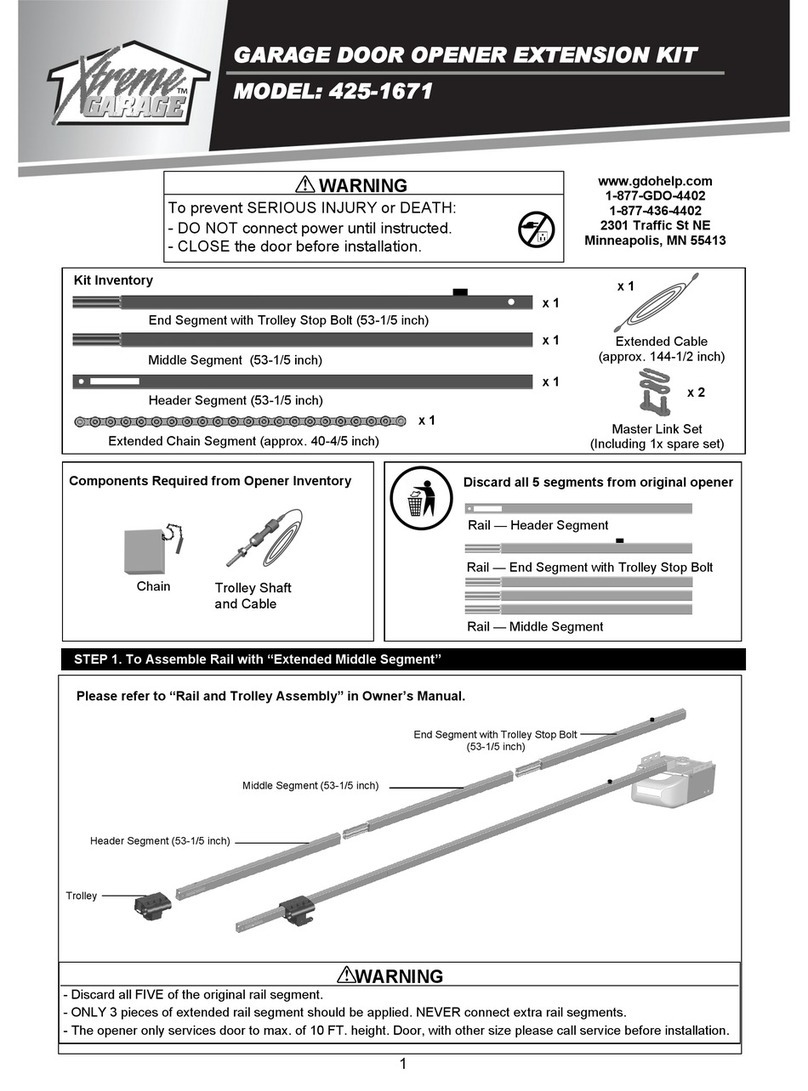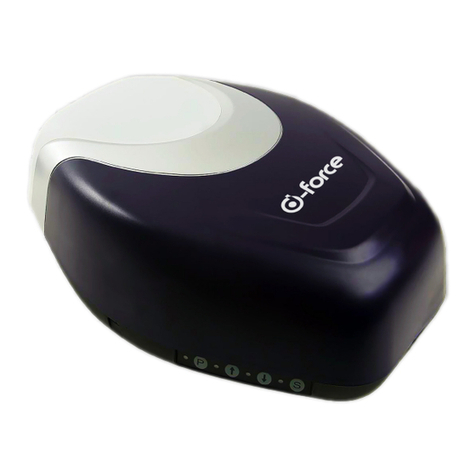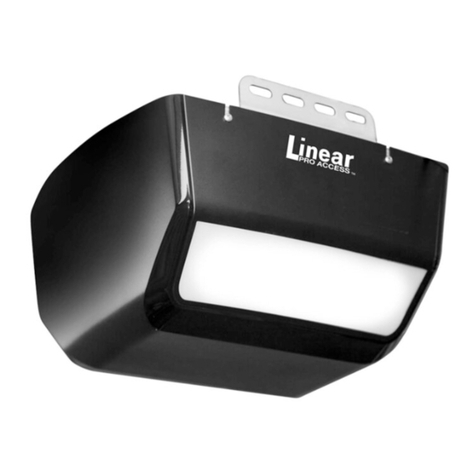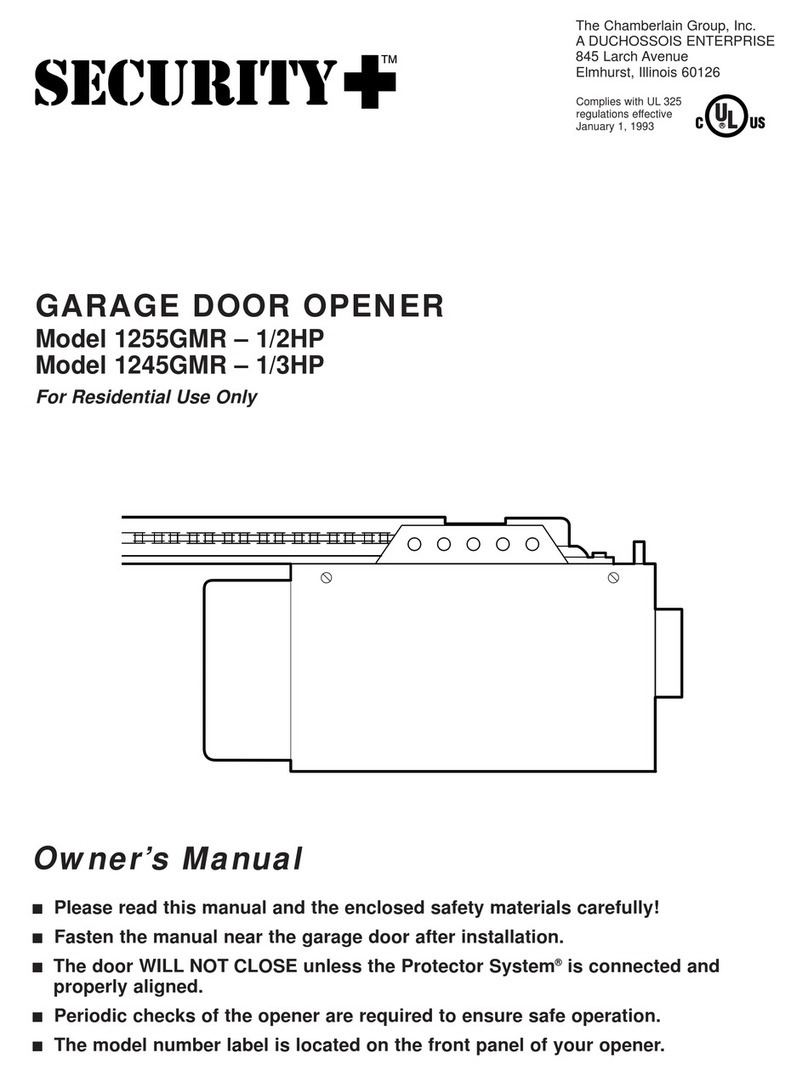Grifco GSD-SDO User manual

Model GSD-SDO
Chamberlain Australia Pty Ltd
Unit 1, 75 Epping Rd North Ryde NSW 2113
Ph: 1800 638 234
www.grifco.com.au
Ref: 01-38727D
• THIS OPERATOR IS TO BE INSTALLED AND SERVICED BY A TRAINED TECHNICIAN ONLY
• This operator is compatible with Security+ 2.0®accessories
OPERATOR
REQUIRES GRIFCO
MONITORED ENTRAPMENT
PROTECTION
OPERATOR
REQUIRES GRIFCO
MONITORED ENTRAPMENT
PROTECTION
Commercial Sectional Door Operator
With Integral Battery Back Up
GSD-SDO
DC Operator
GSD-R2.4M
Rail for 2.4m Door
GSD-R3.6M
Rail for 3.6m Door
GSD-RKIT
Hardware Kit for
Custom Rail Length
up to 6m
INSTRUCTION MANUAL

2
WARNING:
Important safety instructions
It is important for the safety of persons to follow all instructions.
SAVE these instructions
WARNING
CAUTION
WARNING
This commercial door operator has been designed and tested to offer safe service provided it is installed, operated, maintained and tested
in strict accordance with the instructions and warnings contained in this manual.
Mechanical
Electrical
When you see these Safety Symbols and Signal Words on the
following pages, they will alert you to the possibility of serious
injury or death if you do not comply with the warnings that
accompany them. The hazard may come from something
mechanical or from electric shock.
When you see this Signal Word on the following pages, it will alert
you to the possibility of damage to your commercial door and/or
the commercial door operator if you do not comply with the
cautionary statements that accompany it.
Keep commercial door balanced. Sticking or binding doors must be
repaired. Commercial doors, door springs, pulleys, brackets and their
hardware are under extreme tension and can cause serious personal
injury. Do not attempt to loosen, move or adjust them. Call for commercial
door service.
Permanently fasten all supplied labels adjacent to the wall control as a
convenient reference and reminder of safe operating procedures.
Activate operator only when the door is in full view, free of obstructions
and operator is properly adjusted. No one should enter or leave the
building while the door is in motion.
An electrician must disconnect electric power to the commercial door
operator before making repairs or removing covers.
The actuating member of a biased-off switch is to be located within direct
sight of the door but away from moving parts. Unless it is key operated, it
is to be installed at a minimum height of 1500mm and not accessible to
the public.
Make sure that people who install, maintain or operate the door follow
these instructions. Keep these instructions in a safe place so that you can
refer to them quickly when you need to.
This appliance is not intended for use by persons (including children) with
reduced physical, sensory or mental capabilities, or lack of experience and
knowledge, unless they have been given supervision or instruction
concerning use of the appliance by a person responsible for their safety.
Children should be supervised to ensure that they do not play with the
appliance.
If the operator is installed at a height less than 2.5 metres from floor level
or any other level from which the operator can be accessed (eg
mezzanine) the installer is responsible to fit guards to the operator to
prevent access to the chain drive.
Use the commercial door operator for its intended purpose. The GSD-
SDO S-Drive operator is designed lifting spring-balanced sectional doors.
Disengage all existing commercial door locks to avoid damage to
commercial door. Install the wall control (or any additional push buttons) in
a location where the commercial door is visible during operation . Do not
allow children to operate push button(s) or remote transmitter(s). Serious
personal injury from a closing commercial door may result from misuse of
the operator.
Do not wear rings, watches or loose clothing while installing or servicing a
commercial door operator.
To avoid serious personal injury from entanglement, remove all ropes
connected to the commercial door before installing the door operator.
After the installation a final test of the full function of the system and the
full function of the safety devices must be done.
When operating a biased-off switch, make sure that other persons are
kept away.
The operator cannot be used with a driven part incorporating a wicket
door (unless the operator cannot be operated with the wicket door open).
Motor may become hot during operation. Appropriate clearance and/or
shielding should be supplied by the installer to ensure any cabling, wiring
and/or other items cannot come in contact with the motor. If temperature
rise exceeds 50°C all fixed wiring insulation must be protected, for
example, by insulating sleeving having an appropriate temperature rating.
THESE ARE IMPORTANT SAFETY INSTRUCTIONS. FOLLOW ALL INSTRUCTIONS AS INCORRECT
INSTALLATION CAN LEAD TO SEVERE INJURY OR DEATH
Installation and wiring must be in compliance with your local building and
electrical codes. Connect the power supply cord only to properly earthed
mains. If the supply cord is damaged, it must be replaced by the
manufacturer, its service agent or similarly qualified persons in order to
avoid a hazard.
Moisture and water can destroy the electronic components. Make sure
under all circumstances that water moisture or storage moisture cannot
penetrate the electronics. The same applies for openings and cable
entries.
SAFETY SYMBOL AND SIGNAL WORD REVIEW

3
CARTON INVENTORY
GSD-SDO DC Operator
GSD-R2.4M 2.4 m Rail
GSD-R3.6M 3.6 m Rail
GSD-RKIT Rail Kit for Custom Length
(6m max)
Battery 12 Vdc 7AH (2)
INTRODUCTION
CONTENTS
NOT SHOWN:
Door Bracket
J-Bar
Fasteners
Documentation Packet
Chain
SAFETY
SAFETY SYMBOL AND SIGNAL WORD REVIEW ..................... 2
INTRODUCTION 3
CARTON INVENTORY................................................................ 3
OPERATOR SPECIFICATIONS................................................... 4
OPERATOR OVERVIEW ............................................................. 5
CONTROL BOARD OVERVIEW.................................................. 6
EXPANSION BOARD OVERVIEW ............................................... 7
INSTALLATION 8
CONNECT RAIL TO OPERATOR ............................................... 8
MOUNT THE OPERATOR .......................................................... 8
ELECTRICAL CONNECTION AND DOOR ATTACHMENT.......... 9
CONNECT BATTERIES .............................................................. 9
DISCONNECT BATTERIES......................................................... 9
COMMISSIONING 10
LIMIT SETTING......................................................................... 10
TYPES OF MONITORED ENTRAPMENT PROTECTION........... 11
SELECTION OF ENTRAPMENT PROTECTION SYSTEM ......... 11
COMMISSIONING ENTRAPMENT PROTECTION SYSTEMS ... 12
FORCE SETTING AND FINE ADJUSTMENT............................. 13
TYPES OF SECURITY +2.0 TRANSMITTERS........................... 14
COMMISSIONING REMOTE TRANSMITTERS ......................... 15
ACCESSORY WIRING ............................................................ 17
CONNECTING ACCESS CONTROL ACCESSORIES ............... 17
CONNECTING EXTERNAL CONTROL DEVICES...................... 17
MISECLLANEOUS WIRING ...................................................... 18
OPERATION 18
RESET BUTTON ...................................................................... 18
OPERATOR ALARM................................................................. 19
MANUAL DISCONNECT........................................................... 19
EXPANSION BOARD 20
AUXILIARY RELAYS ................................................................. 20
WIRING ACCESSORIES TO THE EXPANSION BOARD ........... 21
MAINTENANCE 22
MAINTENANCE CHART ........................................................... 22
BATTERY MAINTENANCE ....................................................... 22
TROUBLESHOOTING 23
VIEWING DIAGNOSTIC CODES ............................................... 23
DIAGNOSTIC CODES CHART.................................................. 25
CONTROL BOARD LEDS......................................................... 27
TROUBLESHOOTING CHART.................................................. 28
SERVICE AND REPAIR PARTS ................................................ 30
WIRING DIAGRAM 31
CHAMBERLAIN LIMITED WARRANTY 32

4
OPERATOR SPECIFICATIONS
Main AC Power Supply 230-240 VAC 50Hz, 400W
Rated Load (R/T) 270N (Continuous)
System Operating Voltage 24 VDC Transformer Run / Battery Backup
Accessory Power 24 VDC, 500 mA max. for ON and SW (switched)
Maximum Door Heights (Rail Part No.) 2.4m (GSD-R2.4M)
3.6m (GSD-R3.6M)
6.0m (GSD-RKIT - rail angle not supplied)
Maximum Door Weight 315.5 kg balanced door
Maximum Door Area 26m²
Travel Speed 20cm per second
Maximum Duty Cycle Continuous
Operating Temperature +5°C to +40°C
Expansion Board Included
Compliance AS/NZS 60335-1
AS/NZS 60335-2-103
Usage Indoor Use Only
INTRODUCTION
2.4 m Rail GSD-R2.4M: 3,380 mm
3.6 m Rail GSD-R3.6M : 4,580 mm
146 mm
490 mm
445 mm 200 mm
50 mm

5
EXPANSION
BOARD
CONDUIT ENTRY /
EXIT TOP OF
OPERATOR
GSD-STAR1000EVO
MOUNTING
(NOT INCLUDED)
LOCKABLE LID
CHAIN GUARD
MOTOR
GEAR BOX
CONTROL BOARD
CONDUIT ENTRY / EXIT
REAR OF OPERATOR
ANTENNA CONNECTION
RESET BUTTON
ACCESS CONTROL DEVICE
EXTERNAL TERMINAL BLOCK
AC POWER
SWITCH
EMI BOARD
INTRODUCTION
PE Beams (Sold Separately)
Make sure the door opens and closes smoothly.
Door should stay in the open position when
springs are properly balanced.
WARNING
Always wear protective gloves and eye protection when changing
the battery or working around the battery compartment.
OPERATOR OVERVIEW

6
CONTROL BOARD OVERVIEW
1. SET OPEN Button: The SET OPEN button sets the OPEN limit. See Adjust Limits section
2. SET CLOSE Button: The SET CLOSE button sets the CLOSE limit. See Adjust Limits section.
3. MOVE GATE Buttons: The MOVE GATE buttons will either open or close the door when the operator is in Limit setting mode.
See Adjust Limits section
4. BATT FAIL:
• When AC power is OFF and battery voltage is critically low the door will latch at a limit until AC power is restored or Batteries
voltage increases
• Option select switch set to OPEN forces door to automatically open and then latch at the OPEN limit until AC power is restored or
battery voltage increases
• Option select switch set to CLOSE forces door to latch at CLOSE limit if at CLOSE limit or on next CLOSE Command until AC
power restored or battery voltage increases
• Constant pressure on a hard command input overrides to open or close the gate/door
• Critically low battery is less than 23V
5. BIPART DELAY Switch: Not used in this application, ensure switch remains in OFF position
6. LEARN Button: The LEARN button is for programming remote transmitters and the network.
7. TIMER-TO-CLOSE dial: The TIMER-TO-CLOSE (TTC) dial can be set to automatically close the door after a specified time period.
The TTC is factory set to OFF. If the TTC is set to the OFF position, then the door will remain open until the operator receives another
command from a control. Rotate the TIMER-TO-CLOSE dial to the desired setting. The range is 0 to 180 seconds, 0 seconds is OFF
NOTE: Any radio command, single button control, or CLOSE command on the control board prior to the TTC expiring will close the
door. The TTC is reset by any signals from the open controls, loops, close edges, and close photoelectric sensors (IR’s)
8. REVERSAL FORCE dial: The REVERSAL FORCE dial adjusts the force. See Force Adjustment section
9. TEST BUTTONS: The TEST BUTTONS will operate the door (OPEN, STOP and CLOSE)
10. STATUS LEDs: The STATUS LEDs indicate the status of the operator. See Status LED Chart in the Troubleshooting section
11. Diagnostic Code Display: The diagnostic code display will show the operator type, firmware version, and diagnostic codes. The
operator type will display as "Gd" followed by a "24" which indicates the operator type as GSD-SDO. The firmware version will show
after the operator type, example "1.2"
12. BACKDRIVE Switch: MUST BE set to SECURE
1 2 4 5 6
7 8
9
10
12
11
3
INTRODUCTION

7
EXPANSION BOARD OVERVIEW
SBC
OPN
CLS
STP
COM
EYE
ONLY
EYE/
EDGE
EYE/
EDGE
COM
1
2
3
OPEN
CLOSE
TO MAIN
BOARD
POWER
10
1 2 3 4
5 6 7
9
8
1 QUICK CLOSE Switch:
OFF: No change to the door's normal operation.
ON: When CLOSE EYES/Interrupt loop is deactivated it causes
an opening or a stopped door to close (ignores the Timer-to-
Close).
2 AC FAIL Switch:
OPEN: Loss of AC power will cause the door to open
approximately 15 seconds after AC power fail and remain OPEN
until AC power is restored (enabling the Timer-to-Close).
BATT: With loss of AC power, door will remain in present position
and operator is powered from batteries.
3 EXIT LOOP FAIL Switch:
OPEN: if the EXIT plug-in loop detector detects a fault, then
the door will open and remain open until fault is cleared.
CLOSE: The plug-in EXIT loop detector faults are ignored (EXIT
loop is faulted and inoperative
4 ANTI-TAIL Switch:
OFF: When CLOSE EYES/Interrupt loop is activated it causes a
closing door to stop and reverse.
ON: When CLOSE EYES/Interrupt loop is activated it causes a
closing door to pause. Once the vehicle is clear the door will
continue to close.
5 AUX RELAY Switches: Set the AUX RELAY switches as need-
ed to obtain the desired function as shown on pages 20-21.
6 EYE/EDGE Switches: Set the EYE/EDGE switches as needed
to obtain the desired OPEN or CLOSE functionality.
7 1, 2, and 3 LEDs: LEDs indicating the status of the EYE/EDGE
inputs. Also used to check the firmware version of the expansion
board:
1. Locate the 1, 2, and 3 LEDs on the expansion board.
2. Disconnect AC/DC power to the main control board for 15
seconds.
3. Connect power. The 1, 2, and 3 LEDs will flash in sequence
until the main control board firmware revision is displayed.
When the green POWER LED glows solid the LED 1 will flash
the version number, then stop, then the LED 2 will flash the
revision number (for example: For version 5.1 when the green
POWER LED is solid the LED 1 will flash 5 times, then stop,
then the LED 2 will flash once).
8 MAIN BOARD Input: Input Connection for the main board
connector.
9 Input LEDs: LEDs indicating the status of the SBC, OPN, CLS,
and STP inputs.
10 Loop Detector Inputs: Inputs for the Plug-In Loop Detectors
WARNING
To AVOID damaging the circuit board, relays or accessories, DO NOT connect more than 42 Vdc (32 Vac) to the
AUX relay contact terminal blocks.
INTRODUCTION

8
Chain Guard
Trolley Rail
Chain
STEP 1
CONNECT RAIL TO OPERATOR
BEFORE INSTALLATION, ENSURE THE OPERATOR IS SUITABLE FOR THE TYPE AND SIZE OF THE DOOR. ENSURE THE
TEMPERATURE RANGE MARKED ON THE OPERATOR IS SUITABLE FOR THE LOCATION OF THE INSTALLATION.
ENSURE THAT THE DRIVEN PART IS IN GOOD MECHANICAL CONDITION, CORRECTLY BALANCED
AND OPENS AND CLOSES PROPERLY.
INSTALLATION
1
2/7
4
6
3
5
STEP 2
MOUNT THE OPERATOR
1. With the door closed, mark the centre of the door on the
wall above the door
2. Open the door and mark the centre of the door on the
ceiling. Ensure height of the rail has the correct clearance
with the door in the open position (see diagram right)
3. Close the door, mount the header bracket and rail
assembly to the wall. Make sure the header bracket is in
the centre of the door opening
4. Lift the operator and align with the centre mark on the
ceiling. Temporarily support the operator
5. Attach operator to ceiling using lateral mounting brackets.
Ensure at least 1 fixing on either side of the operator
6. Attach the door bracket to the door
7. Attach the push arm to the trolley, test emergency release
rope is operational. Attach the J-bar to the push arm
8. Attached J-bar to door bracket after following STEP 3 on
the next page
Header Bracket
J-bar
20°
Door Bracket
Push Arm
NOTE: U-shape bracket
with square holes
indicates the end of the
rail that connects to
the operator.
Emergency Release Rope
NOTE: Trolley can not be
moved independantly of chain.
For attaching the J-bar to the
door bracket, trolley needs to
be positioned by using the
operator. Follos STEP 3 on the
next page.
NOTE: Lateral mounting plates are provided with multiple holes.
Alternate holes to the installation can be used to temporarily suspend
the operator (with ropes, hooks etc not provided) during mounting.
1. Position the operator and rail as shown below
2. Open the cover and remove the chain guard
3. Secure the rail to the operator with the square-neck bolts and Nylock nuts provided.
NOTE - Do not use washers with these nuts
4. Cut the cable ties securing the chain
(The trolley should be approximately 1m from the end of the rail)
5. Remove tensioner nut (shown as (6) below) and wrap the chain around the
output sprocket
6. Reconnect the tensioner nut and tighten until chain hangs approx 10mm
below horizontal
7. Replace chain guard

9
STEP 3
ELECTRICAL CONNECTION AND DOOR ATTACHMENT
STEP 4
CONNECT BATTERIES
DISCONNECTING BATTERIES
Connect the operator to the mains power supply using the pre-connected mains plug to a 10A general power outlet
NOTE: After electrical connection, J-bar can be attached to door bracket by activating the operator. Press the "MOVE
GATE" buttons to position the trolley / J-bar assembly so it can be attached to the door bracket. Push arm should be
approx 20° from vertical
The batteries are charged in the circuit by the integrated transformer. The batteries are for battery backup
1. SEE WARNING! Unplug the J15 plug labelled BATT on the control board by squeezing the plug and pulling it from the control
board. This disconnects the ac/dc power to the control board
2. Loosen the screws on the battery cover and rotate out of the way
3. Connect the red wire to the positive (+) terminal on one battery and connect the black wire to the negative (-) terminal
on the other battery
4. Connect the black jumper (included with the batteries) between the positive (+) terminal of one battery to the
negative (-) terminal of the other battery
5. Insert the batteries as shown
6. Reattach the battery cover
7. Insert the J15 plug back into the control board. This will power up the control board. NOTE: You may see a
small spark when plugging the J15 plug into the board
8. Turn ON AC power at the wall switch
9. Turn ON the AC power switch on the rear of the operator
1. Turn OFF the AC power switch on the rear of
the operator
2. Turn OFF the power at the wall switch
3. SEE WARNING Remove the J15 plug from the
control board
4. Loosen the screws on the battery cover and
rotate out of the way
5. Carefully remove batteries and disconnect all
wires from the battery terminals
6. Dispose of used batteries responsibly
7. Follow instructions above to connect new
batteries
OPERATOR WILL NOT FUNCTION WITHOUT
GRIFCO BATTERIES CONNECTED
INSTALLATION
Black jumper
provided with
batteries
Black Wire (-)
Red Wire (+)
J15 Plug
1/7
9
2/6
3
4
5
WARNING
Batteries are supplied charged. When batteries are connected the operator is fully functional without AC power connected.
NOTE: Batteries are supplied fully charged.
They are automatically charged when
operator is connected to mains power.
WARNING
FAILURE TO DISCONNECT J15 PLUG LABELLED BATT WILL RESULT
IN POTENTIAL SHOCK HAZARD (FOLLOW STEP 4, POINT 1)

10
The door MUST be attached to the operator before setting the limits
and force.
1. Press and release the SET OPEN and SET CLOSE buttons
simultaneously to enter limit setting mode
2. Press and hold one of the MOVE GATE buttons to move the
door to the open or close limit
3. Press and release the SET CLOSE or SET OPEN button
depending on which limit is being set
4. Press and hold one of the MOVE GATE button to move the door
to the other limit
5. Press and release the SET CLOSE or SET OPEN button
depending on which limit is being set
6. Cycle the door open and close by pressing the green "TEST
BUTTONS" (Open and Close). This automatically sets the force
When limits are set properly the operator will automatically exit limit
setting mode.
INTRODUCTION
Your operator is designed with electronic controls to make travel
limit and force adjustments easy. The adjustments allow you to
program where the door will stop in the open and close position.
The electronic controls sense the amount of force required to open
and close the door.
The force is adjusted automatically when you program the limits but
can be fine tuned using the REVERSAL FORCE dial on the control
board (refer to Fine Tune the Force section) to compensate for
environmental changes.
The limit setup LEDs (located next to the SET OPEN and SET
CLOSE buttons) indicate the status of the limits, refer to
the table below.
LIMIT SETTING
LIMIT SETUP LEDS
SET OPEN
LED
SET CLOSE
LED OPERATOR MODE EXPLANATION
OFF OFF NORMAL MODE Limits are set
BLINKING BLINKING LIMIT SETTING MODE Limits are not set
BLINKING ON LIMIT SETTING MODE Open limit is not set
ON BLINKING LIMIT SETTING MODE Close limit is not set
ON ON LIMIT SETTING MODE Limits are set
DIAGNOSTICS
DIAGNOSTICS
12
3
4
5
WARNING
• NEVER increase force beyond minimum amount required to
move door.
• NEVER use force adjustments to compensate for a binding or
sticking door.
• If one control (force or travel limits) is adjusted, the other control
may also need adjustment.
The limits can be set using the control board (below) or a remote transmitter (refer to Limit Setup with a Remote Transmitter in the
Programming section). Setting the limits with a remote transmitter requires a 3-button transmitter programmed to OPEN, CLOSE, and STOP.
NOTE: The Test Buttons on the control board will not work until the limits have been set.
COMMISSIONING

11
Part No. GLCPS
Description Grifco Light Curtain Protector System - plug-in monitored send/receive light
curtain (Inc light curtains, mount system & cable)
MONITORED LIGHT CURTAIN
The Grifco Light Curtain offers the ultimate in superior safety. Regardless of
the application, the multiple angled light beams create a field of entrapment
protection ensuring unsupervised closing doors operate in a safe manner.
Part No. GPS15 Plug-in monitored Reflective Beam
For door widths up to 15m
MONITORED REFLECTIVE SAFETY BEAM KIT
When utilised as part of a Monitored Entrapment Protection System, these
beams offer exceptional safety for auto-closing doors. If an obstruction is
detected the door will stop and reverse. The reflective beam requires wiring to
only one side of the door opening.
Part No. GPS772 Plug-in monitored Send / Receive Beam
For door widths up to 15m
MONITORED SEND / RECEIVE SAFETY BEAM KIT
Send / Receive beams are ideal for emergency services facilities. Wiring is
required down both sides of the door opening.
Part No.
BMSE30K
(other lengths
available)
Wired safety edge 3,000mm
MONITORED SAFETY EDGE
Safety edge is mounted to the bottom of the door and detects obstructions
upon contact.
A monitored safety device requires a dedicated control system to
actively supervise the state of the safety sensor to ensure that any
kind of sensor failure will be detected, preventing the door from
operating unsafely. Non-compliant safety sensors, relying on a
non-monitored, normally-closed contact, can be bypassed or
fail to operate in the event of damage or tampering. Entrapment
Protection Systems must be monitored to form part of a compliant
system.
This operator provides a range of open and close automation options
and therefore entrapment protection devices must be fitted to ensure
compliance to the relevant standard (AS/NZS 60335-2-103).
Methods used to provide safety and compliance are determined by
the functional requirements of the installation and the door type. It is
the responsibility of the installer to ensure the installation meets the
requirements of AS/NZS 60335-2-103.
GRIFCO offers a range of entrapment protection devices including
Safety Beams, Light Curtains, and Safety Edges. An example sectional
door installation using GRIFCO entrapment protection devices is shown
right.
TYPES OF MONITORED ENTRAPMENT PROTECTION
SELECTION OF ENTRAPMENT PROTECTION SYSTEM
COMMISSIONING
Safety Beam 80-90mm from ground
(GPS15 / GPS772)
Safety Edge (BMSE30K)
NOTE: Where a grill type door is installed with openings ≥50mm protection in the opening direction is required. This can be
achieved with the installation of a monitored safety beam mounted on the outside of the door to protect against entrapment
protection / collision with the door lintel. GRIFCO monitored Safety Beams must be used to provide protection.
For applications with no monitored entrapment protection, the operator can be controlled using the on-board "OPEN /
CLOSE / STOP" inputs with the use of a hold-to-close push button accessory. See page 18 for installation instructions.

12
Close Photoelectric
Sensors
Close Edge
Open Edge
Open Photoelectric
Sensors
OR
SHADOW INTERUPT EXIT
SBC
OPN
CLS
STP
COM
EYE
ONLY
EYE/
EDGE
EYE/
EDGE
COM
1
2
3
OPEN
CLOSE
TO MAIN
BOARD
POWER
SBC
OPN
EYE
ONLY
EYE/
EDGE
EYE/
EDGE
COM
1
2
3
OPEN
CLOSE
TO MAIN
BOARD
Photoelectric Sensors
Edge Sensor
Photoelectric Sensors OR
Photoelectric Sensors
OR
Edge Sensor
CONTROL BOARD
CLOSE EYES (Infrared Safety Beams)
The CLOSE EYES/INTERRUPT input is for PE beam entrapment
protection in the CLOSING direction. When an obstruction is
detected during closing, the door will stop and open to the fully
open position. Timer to close will be reset. This input will be
disregarded during opening.
EXPANSION BOARD
CLOSE EDGE (Safety or Bump Edge)
The CLOSE EDGE input is for monitored (8K2) contact edge
sensor entrapment protection for the close direction. When an
obstruction is detected during closing, the door will stop and
open to the fully open position. Timer to close will be disabled
after a second obstruction is detected. This input will be
disregarded during opening.
EYE ONLY and COM
Open or Close direction PE beams with selectable functionality.
EYE/EDGE and COM (x2)
Open or Close direction PE Beams OR contact edge sensors
with selectable functionality.
DIP SWITCH SETTINGS
The DIP Switches located next to the terminals have the following
functions:
Set to Close:
The door will stop and reverse to open when an obstruction
is detected.
Set to Open:
The door will stop and retract when an obstruction is detected.
OPEN EYES/EDGE
The OPEN EYES/EDGE input is for PE beams or contact edge
sensor entrapment protection for the open direction.
When an obstruction is detected during opening, the door will
stop and travel down for 2 seconds. This input will be
disregarded during closing.
Open Eyes / Edges can be used on doors that may present an
entrapment danger in the opening direction.
COMMISSIONING
COMMISSIONING ENTRAPMENT PROTECTION SYSTEMS
DIAGNOSTICS
Example installation
shown
Brown
Blue
TO REMOVE AND ERASE MONITORED ENTRAPMENT PROTECTION
DEVICES
1. Remove the entrapment protection device wires from the terminal block.
2. Press and release the SET OPEN and SET CLOSE buttons simultaneously.
The SET OPEN and SET CLOSE LEDs will turn on
(entering learn limit mode).
3. Press and release both SET OPEN and SET CLOSE buttons again to turn
off the SET OPEN and SET CLOSE LEDs (exiting learn limit mode).

13
FORCE SETTING AND FINE ADJUSTMENT
2
3
1
SET THE FORCE
With entrapment protection attached, cycle the door open and
closed using the green "TEST BUTTONS". The operator will
automatically set the force.
FINE TUNE THE FORCE
The REVERSAL FORCE DIAL on the control board is used for fine
tuning the force in cases where wind or environmental changes
may affect the door travel.
Based on the length and weight of the door it may be necessary to
make additional force adjustments. The force setting should be
high enough that the door will not cause nuisance reversals, but
low enough to prevent damage to door or property. The force
setting is the same for both the open and close directions.
1. Open and close the door with the TEST BUTTONS.
2. If the door stops or reverses before reaching the fully open or
closed position, increase the force by turning the force control
slightly clockwise.
3. Perform the “Obstruction Test” after every force setting
adjustment (see below).
OBSTRUCTION TEST
The operator is equipped with an automatic obstruction sensing
feature.
If the door encounters an obstruction during motion, the operator
will automatically reverse or stop the door. After any adjustments
are made, test the operator:
1. Open and close the door with the TEST BUTTONS, ensuring
that the door is stopping at the proper open and close limit
positions.
2. Place a solid object under the open door. Ensure that the
door, and the solid object can withstand the forces generated
during this obstruction test.
3. Run the door in the close direction. The door should stop and
reverse upon contact with the solid object. If the door does
not reverse off the solid object, reduce the force setting by
turning the force control slightly counter-clockwise. The door
should have enough force to reach both the open and close
limits, but MUST reverse after contact with a solid object.
SETTING TIMER-TO-CLOSE
The TIMER-TO-CLOSE (TTC) dial can be set to automatically close
the door after a specified time period.
The TTC is factory set to OFF. If the TTC is set to the OFF position,
then the door will remain open until the operator receives another
command from a control. Rotate the TIMER-TO-CLOSE dial to the
desired setting. The range is 0 to 180 seconds, 0 seconds is OFF.
NOTE: Any radio command, single button control, or CLOSE
command on the control board prior to the TTC expiring will close
the door. The TTC is reset by any signals from the open controls,
loops, safety edges, and close photoelectric sensors (IR’s).
COMMISSIONING

14
COMMISSIONING
All Grifco remote access devices feature Security +2.0 technology. This
advanced platform cuts through interference, and ensures consistent,
reliable, long range operation of your commercial door.
With inbuilt perpetual rolling code technology, Grifco Security +2.0
transmitters are safe and secure. All devices feature exceptional battery life,
easy configuration and long range.
TYPES OF SECURITY +2.0 TRANSMITTERS
WIRELESS WALL CONTROL
WIRELESS 3-CHANNEL
KEYRING TRANSMITTER
WIRELESS 4-CHANNEL
KEYRING TRANSMITTER
WIRELESS VISOR TRANSMITTER
WIRELESS SECURITY KEYPAD
Part No. E138G
Description
2-channel transmitter for wall
mounting on internal walls
Security +2.0
Part No. E840G
Description
Wireless keypad for external
keyless entry
Security +2.0
Part No. E943G
Description
3-channel transmitter for vehicle
or forklift mounting
Security +2.0
Part No. E945G
Description 3-channel keyring transmitter
Security +2.0
Part No. E960G
Description 4-channel keyring transmitter.
Security +2.0 / Security+
Part No. GSD-STAR1000EVO
Description
Transmitter management for up
to 1,000 Security +2.0 remote
access devices
TRANSMITTER MANAGEMENT SYSTEM
The GSD-STAR1000EVO is ideal for
applications requiring multiple remote access
devices.
It supports up to 1,000 Security +2.0
transmitters which can be programmed through
the onboard keypad and LCD screen.
Transmitters can be added or deleted singularly
or in groups via an access code for added
security. Transmitters can be coded offsite and
backed up via an onboard memory chip. It is
supplied with an antenna for exceptional range
and is rated IP44 for water resistance.
GSD-STAR1000EVO is supplied with a bracket
and wiring for internal mounting into the S-Drive
operator.
The GSD-STAR1000EVO can be mounted
internal to the S-Drive operator. See page 18
for details.

15
COMMISSIONING REMOTE TRANSMITTERS (SOLD SEPARATELY)
ERASING TRANSMITTERS OR LIMITS
MOUNTING GSD-STAR1000EVO
A total of 50 Security+ 2.0 remote transmitters and 2 wireless
keypads (1 PIN for each wireless keypad) can be programmed to
the operator. When programming a third wireless keypad to the
operator, the first wireless keypad will be erased to allow the third
wireless keypad to be programmed.
When the operator’s memory is full it will exit the programming
mode and the remote transmitter will not be programmed. The
memory will need to be erased before programming any additional
remote transmitters.
Ensure supplied antenna is fitted to the operator prior to
programming transmitters.
The operator will automatically exit learn mode (operator will beep and green XMITTER LED will go out) if programming is successful. To
program additional Security+ 2.0 remote transmitters or transmitter buttons, repeat the programming steps above.
OPTION DESCRIPTION PROGRAM USING OPERATOR'S LEARN BUTTON
Single button as OPEN
only
Program a single button on the
remote transmitter for open only.
The Timer-to-Close can be set to
close the door.
1. Press and release the LEARN button (operator will beep and green XMITTER LED
will light). NOTE: The operator will time out of programming mode after 30 seconds.
2. Press the OPEN button.
3. Press the remote transmitter button that you would like to program.
Single button (SBC) as
OPEN, CLOSE, and STOP
(Remote transmitter
behaviour will become
"open only" when TTC is
set
Program one transmitter button
as an open, close, and stop.
1. Press and release the LEARN button (operator will beep and green XMITTER LED
will light). NOTE: The operator will time out of programming mode after 30 seconds.
2. Press the remote transmitter button that you would like to program.
Three separate buttons as
OPEN, CLOSE, and STOP
Program each remote transmitter
button as an open, close, and
stop.
1. Press and release the LEARN button (operator will beep and green XMITTER LED
will light). NOTE: The operator will time out of programming mode after 30 seconds.
2. Press the OPEN, CLOSE, or STOP button, depending on the desired function.
3. Press the remote transmitter button that you would like to program.
COMMISSIONING
ERASE ALL CODES
1. Press and release the LEARN button (operator will beep and green XMITTER LED will light).
2. Press and hold the LEARN button again until the green XMITTER LED flashes and then release the button (approximately 6 seconds). All
remote transmitter codes are now erased
The GSD-STAR1000EVO (sold separately) is designed to fit internally to the operator.
1. Mount the STAR1000EVO device to the mounting bracket
2. Mount the assembly (STAR1000EVO and bracket) to the internal chassis of the
operator using the at the position shown right using the screws and bracket provided
(ensure the antenna is mounted external to the operator)
3. Connect the cable to the Main Control Board as shown on page 18.
ERASE LIMITS
1. To erase the limits, press and hold the SET OPEN and SET CLOSE buttons simultaneously (5 seconds) until both the SET OPEN and
SET CLOSE LEDs blink rapidly and the operator beeps.
2. Release the buttons and the SET OPEN and SET CLOSE LEDs will blink slowly indicating the limits have been erased.
Mounting position of
GSD-STAR1000EVO

16
COMMISSIONING REMOTE TRANSMITTERS (CONT.)
LIMIT SETUP WITH A REMOTE TRANSMITTER
To set the limits using a remote transmitter, first you will need a 3-button transmitter that has been programmed for OPEN, CLOSE, and
STOP. Refer to the Programming section.
INITIAL LIMITS AND FORCE ADJUSTMENT
The door MUST be attached to the operator before setting the limits and force.
Ensure the door is closed.
1. Press and release the SET OPEN and SET CLOSE buttons simultaneously to enter limit setting mode.
2. Press and hold the OPEN or CLOSE button on the remote transmitter until the door reaches the desired open position. The door can
be jogged back and forth using the OPEN and CLOSE buttons on the remote transmitter.
3. Once the gate/door is in the desired open position, press and release the STOP button on the remote transmitter.
4. Press and release the OPEN button on the remote transmitter again to set the open limit.
5. Press and hold the CLOSE or OPEN button on the remote transmitter until the door reaches the desired close position. The door can
be jogged back and forth using the OPEN and CLOSE buttons on the remote transmitter.
6. Once the door is in the desired close position, press and release the STOP button on the remote transmitter.
7. Press and release the CLOSE button on the remote transmitter again to set the close limit.
8. Cycle the door open and close. This automatically sets the force. When limits are set properly the operator will automatically exit limit
setting mode.
ADJUST THE LIMITS (if needed)
If the limits have already been set the operator will exit the limit setting mode after resetting each limit.
SET THE CLOSE LIMIT ONLY
1. Press and release the SET OPEN and SET CLOSE buttons simultaneously to enter limit setting mode.
2. Press and hold the CLOSE button on the remote transmitter until the door reaches the desired close position. The Door can be jogged
back and forth using the OPEN and CLOSE buttons on the transmitter.
3. Once the door is in the desired close position, press and release the STOP button on the remote transmitter.
4. Press and release the CLOSE button on the remote transmitter again to set the close limit.
When the close limit is set properly the operator will automatically exit limit setting mode.
SET THE OPEN LIMIT ONLY
1. Press and release the SET OPEN and SET CLOSE buttons
simultaneously to enter limit setting mode.
2. Press and hold the OPEN button on the remote transmitter until the
door reaches the desired open position. The door can be jogged
back and forth using the OPEN and CLOSE buttons on the
transmitter.
3. Once the gate/door is in the desired open position, press and
release the STOP button on the transmitter.
4. Press and release the OPEN button on the transmitter again to set the open limit.
When the open limit is set properly the operator will automatically exit limit setting mode.
DIAGNOSTICS
3-Button Transmitter programmed for
OPEN, CLOSE and STOP
COMMISSIONING

17
OUT
Interrupt
Loop
Exit
Loop
IN
Shadow
Loop
OUT
Interrupt
Loop
Exit
Loop
IN
Shadow
Loop
Com
Com
Com
Exit
Shadow
(control board)
Interrupt
CONNECTING EXTERNAL CONTROL DEVICES
EXIT (2 Terminals)
This input is a soft open command (maintained switch does not
override external safeties and does not reset alarm condition). Used
for exit probe, telephone entry, external exit loop detector, or any
device that would command the door to open.
• Opens a closing door and holds open an open door, if
maintained, pauses Timer-to-Close at OPEN limit.
SHADOW (2 Terminals)
This input is used for external shadow loop detector when loop is
positioned under the swing of the door.
• Holds open door at open limit
• Only active when the door is at the OPEN limit, disregarded at
all other times
• Pauses Timer-to-Close at OPEN limit
INTERRUPT (2 Terminals)
This input is used for photoelectric sensors and external interrupt
loop detector when loop is on the outside of the door.
• Holds open door at open limit
• Stops and reverses a closing door to open limit
• Pauses Timer-to-Close at OPEN limit, activates quick close and
anti-tailgate features when enabled on the expansion board
CONNECTING ACCESS CONTROL ACCESSORIES
Access control devices can either be wired internally to the operator or via the external terminal block.
ACCESSORY WIRING
EXTERNAL CONNECTION
External terminals are provided for installations where 3rd party devices
can be connected without the need to gain entry to the operator enclosure.
Terminals are located on the rear of the operator, near the Reset Button.
DIAGNOSTICS
Normally Open
Access Control
Input
INTERNAL CONNECTION
The diagram below shows where to connect access control
devices such as card readers, keypads or key switches etc.
Normally Open
Access Control
Input

18
OPERATION
MISCELLANEOUS WIRING
THREE BUTTON CONTROL STATION (4 Terminals)
•OPEN and COM: Opens a closed door.
Hard open (maintained switch overrides external safeties and
resets alarm condition). If maintained, pauses Timer-to-Close at
OPEN limit. Opens a closing door and holds open an open door
(within
line-of-sight).
•CLOSE and COM: Closes an open door.
Hard close (maintained switch overrides external safeties and
resets alarm condition within line-of-sight)
•STOP and COM: Stops a moving door.
Hard stop (maintained switch overrides Open and Close
commands and resets alarm condition). Cancels/resets Timer-
to-Close at OPEN limit. Overrides Open and Close commands
(within
line-of-sight).
FIRE DEPARTMENT OPEN INPUT (2 Terminals)
Acts as hard open.
Hard open (maintained switch overrides external safeties and resets
alarm condition). If maintained, pauses Timer-to-Close at OPEN
limit.
Opens a closing door and holds open an open door (within line-of-
sight). Bypasses any prewarning delay.
ACCESSORY POWER 24 VDC, MAX 500 MA (4 Terminals)
•SWITCHED: Switched ON when the door is in motion. Turns off
after a 5 second delay when the door stops. The power will
remain ON at the open limit when Timer-to-Close is enabled and
when the Timer-to-Close is counting down.
•UNSWITCHED: 24 Vdc voltage out to power accessories,
always ON.
Com
Open
(main control board)
Three Button Control Station
Fire Department
Com
Fire Dept
Acc Power +24 Vdc
Com (-)
(main control board)
Accessory Power Unswitched
Accessory Power Switched
Acc Power +24 Vdc
Com (-)
Close
Stop
N.C.
ACCESSORY WIRING
RESET BUTTON
RESET BUTTON
The reset button is located on the back of the operator and serves
several functions:
• Press the reset button to stop a moving door during a normal
open/close cycle, like a stop button.
• Press the reset button once while the door is in open position to
disable the Timer-to-Close. The door will stay in the open
position. To restart the Timer-to-Close either press the reset
button or activate the door with a programmed remote
transmitter.
• Press the reset button to shut off the alarm and reset the
operator.

19
A B
CD
OPERATION
MANUAL DISCONNECT
Hold the J-bar with one arm and pull the release rope
with the other arm.
Lift the door up until fully open
STEP 1 STEP 2
To re-connect, re-attach the push arm by pulling the emergency release rope and connecting to the trolley pin.
Hold J-bar
with one arm
Pull cord in
direction shown
WARNING
Activation of manual release may cause uncontrolled movement of the door due to mechanical failure or out-of-balance conditions.
OPERATOR ALARM
The operator alarm will beep 3 times with a command if the battery
is low.
When the inherent force of the operator (RPM/current sensor)
detects the following (twice consecutively) the alarm will sound (up to
5 minutes) and the operator will need to be reset:
A. The door hits an obstruction
B. The door has a broken wheel(s) or damaged track
C. The door has broken springs or hardware
D. Trolley is hitting the chassis or an unwanted object
Remove any obstructions. Press the reset button to shut off the
alarm and reset the operator. After the operator is reset, normal
functions will resume.

20
CYCLE COUNT
To determine the actual cycles that the door operator has run (in thousands), set all three Aux Relay switches to the ON setting for Aux
Relay 1. The Expansion Board’s 1, 2, and 3 LEDs will blink out the cycle count.
• 1 LED blinking 1000’s
• 2 LED blinking 10,000’s
• 3 LED blinking 100,000’s
• Simultaneously all three LED’s blink 1,000,000’s
Cycle count displayed is between 1,000 and 9,999,000 cycles. After servicing, set Aux Relay switches back to their appropriate positions.
Cycle count cannot be reset or changed. If under 1,000 cycles the 1, 2, and 3 LEDs will turn on for 10 seconds, then turn off.
NOTE: The expansion board will flash the cycle count 3 times then all the LEDs will turn on solid for 10 seconds then turn off.
AUXILIARY RELAYS
AUX RELAY
SETTING
SWITCH
SETTINGS
AUX RELAY 1 AUX RELAY 2
1 2 3
Off (no feature
selected)
OFF OFF OFF Relay always off. Use this Aux Relay setting to conserve battery power.
Open Limit
Switch
OFF OFF ON Energizes at open limit.
Close Limit
Switch
OFF ON OFF Energizes when not at close limit. For an additional audible or visual display,
connect an external light (low voltage).
Door Motion OFF ON ON Energizes when motor is on (door in motion). For an additional audible or visual display,
connect an external buzzer or light (low voltage).
Pre-Motion Delay ON OFF OFF Energizes 3 seconds before door motion and remains
energized during door motion. The on board alarm will
sound. For an additional audible or Visual display, connect
an external buzzer or light (low voltage).
Energizes 3 seconds before door motion and
remains energized during door motion.
For an additional audible or visual display,
connect an external buzzer or light (low voltage).
Power ON ON OFF Energizes when AC power or solar power is present. There
is approximately a 10-12 second delay before relay cutoff,
after AC shutdown.
Energizes when on battery power. There is
approximately a 10-12 second delay before relay
cutoff, after AC shutdown.
Tamper ON OFF ON Energizes if gate/door is manually tampered with by being
pushed off of close limit. For an additional audible or visual
display, connect an external buzzer or light (low voltage).
Energizes if gate/door is manually tampered with by
being pushed off of close limit.
For an additional audible or visual display, connect
an external buzzer or light (low voltage).
Cycle Quantity
Feedback*
ON ON ON The 1, 2, and 3 LEDs will blink out the cycle count (cycle
count is stored on the control board). See below.
Red/green light functionality. See BELOW.
AUX RELAY 1 AND 2
Normally Open (N.O.) and Normally Closed (N.C.) relay contacts to control external devices, for connection low voltage (42 Vdc [34 Vac] max
5 Amps) power sources only.
EXPANSION BOARD
SHADOW INTERUPT EXIT
SBC
OPN
CLS
STP
COM
EYE
ONLY
EYE/
EDGE
EYE/
EDGE
COM
1
2
3
OPEN
CLOSE
TO MAIN
BOARD
POWER
SHADOW
INTERRUPT
EXIT
AUX RELAY 1 AUX RELAY 2
A
UX Relay 2 N.C.
Com
AUX Relay 2 N.O.
AUX Relay 1 N.C.
Com
AUX Relay 1 N.O.
AUX RELAY WIRING EXAMPLE
Aux Relay
Class 2 Power Source
(42 Vdc [34 Vac],
5 A max)
Warning
Light
COM
N.C.
N.O.
+_
AUXILIARY RELAY WIRING
EXAMPLE
AUX RELAY 1 AND 2 WIRING DETAILS
Switch Settings
1 2 3 RELAY 1 RELAY 2
OFF OFF OFF Relay always off Relay always on
OFF OFF ON Energises at open limit Energises at open limit
OFF ON OFF Energises when not at
close limit
Energises when not at
close limit
OFF ON ON Energises when motor
is on
Enegerises when motor
is on
ON OFF OFF
Energises and alarms 3
secods prior and during
door automation
Energises 3 secods
prior and during door
automation
ON ON ON Energises when door is
tampered with
Energises when door is
tampered with
ON OFF ON LEDs will blink cycle
count
Red / Green light
functionality
ON ON ON
Red / Green Light Functionality
Red light wired to AUX RELAY 1
Green Light wired to AUX RELAY 2
Door State AUX RELAY 1 SWITCHES AUX RELAY 2 SWITCHES
1 OFF 2 OFF 3 OFF 1 ON 2 ON 3 ON
CLOSED Red light OFF* Green light OFF
OPENING Red light ON / FLASH Green light OFF
OPEN Red light OFF Green light ON
CLOSING red light ON / FLASH Green light OFF
Defined mid stop N/A N/A
Undefined mid
stop Red light ON Green light OFF
Timer more than
5 seconds Red light OFF Green light ON
Timer less than
5 seconds Red light ON / FLASH Green light OFF
* For red light ON when door is closed, set switch on AUX RELAY 1 to ON
For example, 1 LED blinks 3
times, 2 LED blinks 6 times,
and 3 LED blinks once.
Cycle count is 163,000.
This manual suits for next models
3
Table of contents
Other Grifco Garage Door Opener manuals
Popular Garage Door Opener manuals by other brands
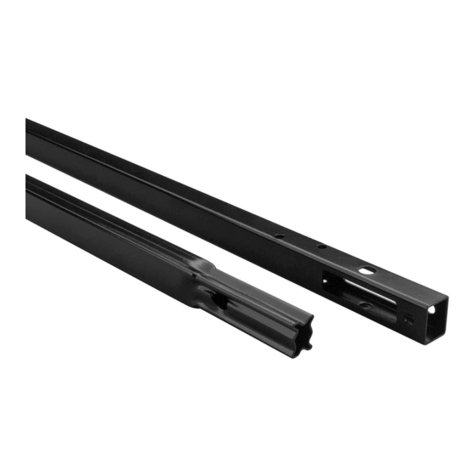
Chamberlain
Chamberlain 7710CB manual
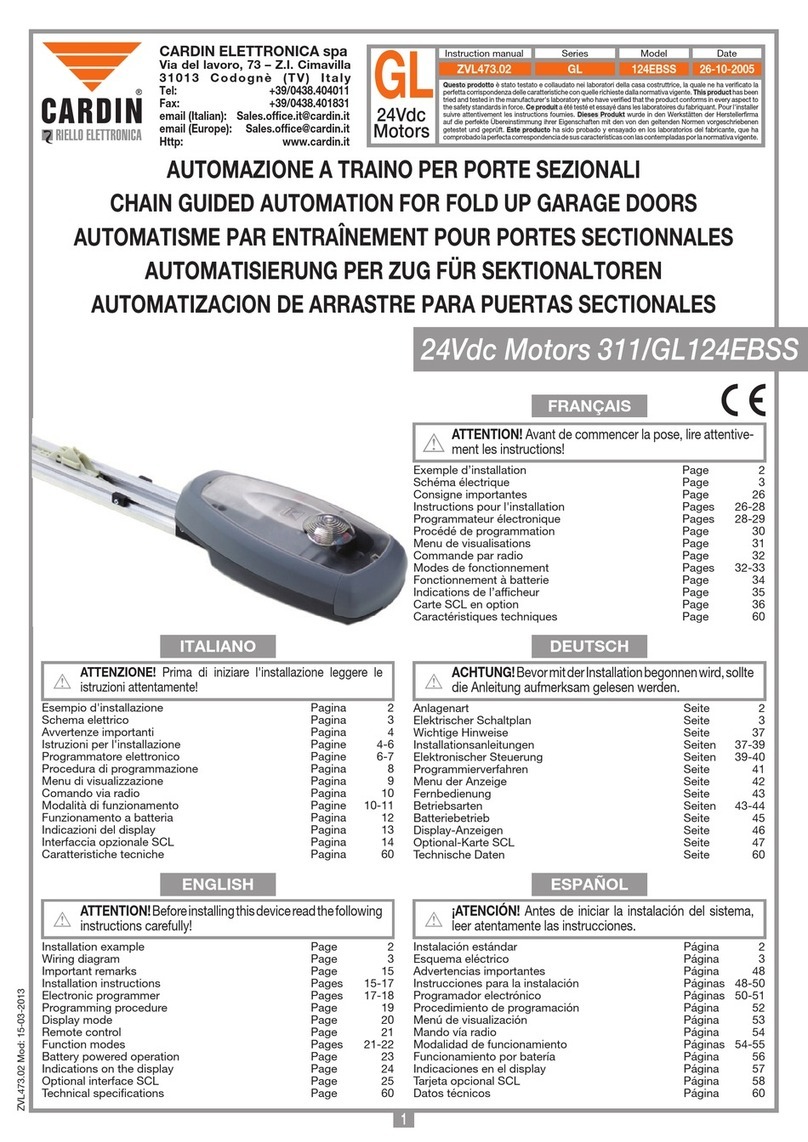
Cardin Elettronica
Cardin Elettronica 311/GL124EBSS instruction manual

Meccanica Fadini
Meccanica Fadini Elpro 220 instructions
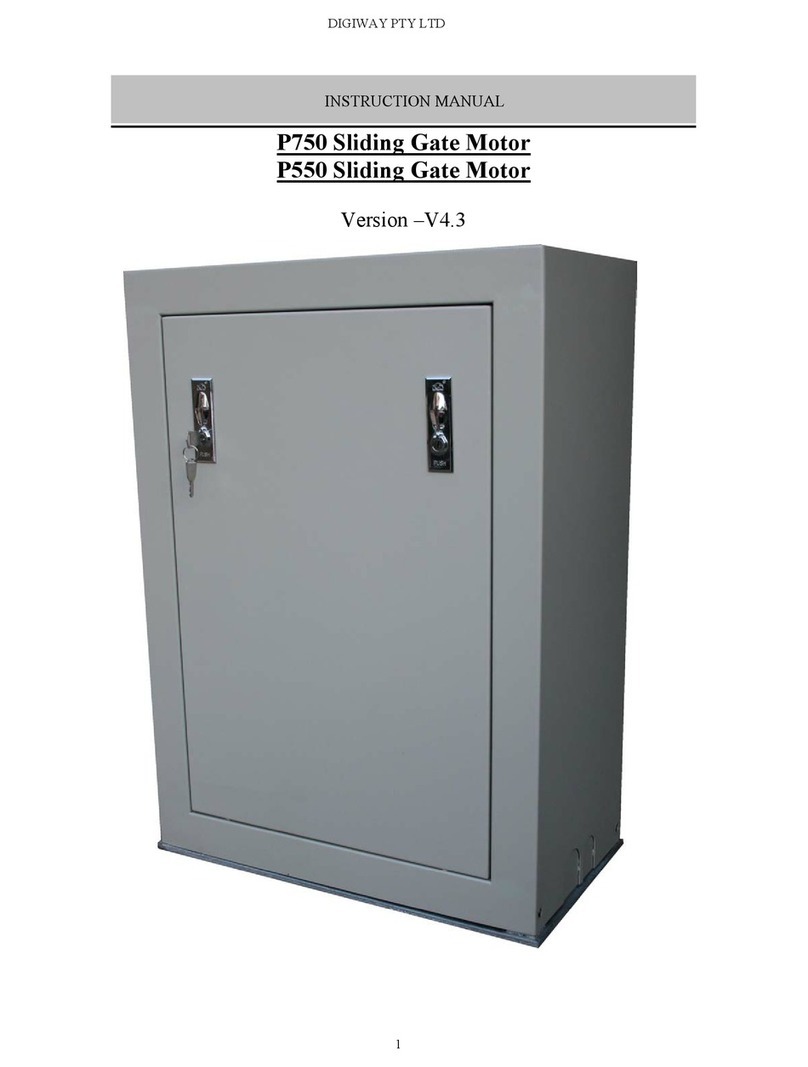
DIGIWAY PTY
DIGIWAY PTY P750 instruction manual

4Ddoors
4Ddoors SOLAR GA201 Instructions for fitting, operating and maintenance

King gates
King gates STARG8 24 quick guide


